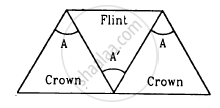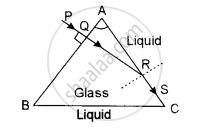Advertisements
Advertisements
प्रश्न
A thin prism of crown glass (μr = 1.515, μv = 1.525) and a thin prism of flint glass (μr = 1.612, μv = 1.632) are placed in contact with each other. Their refracting angles are 5.0° each and are similarly directed. Calculate the angular dispersion produced by the combination.
उत्तर

For crown glass, we have:-
Refractive index for red colour, μcr = 1.515
Refractive index for violet colour, μcv = 1.525
For flint glass, we have:-
Refractive index for red colour, μfr = 1.612
Refractive index for violet colour,μfv = 1.632
Refracting angle, A = 5°
Let:-
δc = Angle of deviation for crown glass
δf = Angle of deviation for flint glass
As prisms are similarly directed and placed in contact with each other, the total deviation produced (δ) is given by
δ = δc + δf
= (μc - 1)A + (μf – 1)A
= (μc + μf – 2)A
For violet light, δv = (μcv + μfv – 2)A
For red light, δr = (μcr + μfr – 2)A
Now, we have:-
Angular dispersion of the combination:-
δv – δr = (μcv + μfv – 2)A – (μcr + μfr – 2)A
= (μcv + μfv – μcr – μfr) A
= (1.525 + 1.632 – 1.515 – 1.612)5
= 0.15°
So, the angular dispersion produced by the combination is 0.15°.
APPEARS IN
संबंधित प्रश्न
A ray of light passes through an equilateral glass prism such that the angle of incidence is equal to the angle of emergence and each of these angles is equal to 3/4 of angle of prism. Find the angle of deviation.
Give the formula that can be used to determine refractive index of materials of a prism in minimum deviation condition ?
The angular dispersion produced by a prism ___________ .
A prism can produce a minimum deviation δ in a light beam. If three such prisms are combined, the minimum deviation that can be produced in this beam is _______________.
A certain material has refractive indices 1.56, 1.60 and 1.68 rfor red, yellow and violet lightespectively. (a) Calculate the dispersive power. (b) Find the angular dispersion produced by a thin prism of angle 6° made of this material.
A thin prism is made of a material having refractive indices 1.61 and 1.65 for red and violet light. The dispersive power of the material is 0.07. It is found that a beam of yellow light passing through the prism suffers a minimum deviation of 4.0° in favourable conditions. Calculate the angle of the prism.
The minimum deviations suffered by, yellow and violet beams passing through an equilateral transparent prism are 38.4°, 38.7° and 39.2° respectively. Calculate the dispersive power of the medium.
Two prisms of identical geometrical shape are combined with their refracting angles oppositely directed. The materials of the prisms have refractive indices 1.52 and 1.62 for violet light. A violet ray is deviated by 1.0° when passes symmetrically through this combination. What is the angle of the prisms?
Three thin prisms are combined as shown in figure. The refractive indices of the crown glass for red, yellow and violet rays are μr, μy and μv respectively and those for the flint glass are μ'r, μ'y and μ'v respectively. Find the ratio A'/A for which (a) there is no net angular dispersion, and (b) there is no net deviation in the yellow ray.

The refractive index of a material M1 changes by 0.014 and that of another material M2 changes by 0.024 as the colour of the light is changed from red to violet. Two thin prisms, one made of M1(A = 5.3°) and the other made of M2(A = 3.7°) are combined with their refracting angles oppositely directed. (a) Find the angular dispersion produced by the combination. (b) The prisms are now combined with their refracting angles similarly directed. Find the angular dispersion produced by the combination.
A narrow beam of monochromatic light, PQ, is incident normally on one face of an equiangular glass prism of refractive index 1.45. When the prism is immersed in a certain liquid, the ray makes a grazing emergence along the other face (See figure). Find the refractive index of this liquid. 
What is meant by the dispersive power of transparent material?
An equilateral glass prism has a refractive index 1.6 in the air. Calculate the angle of minimum deviation of the prism, when kept in a medium of refractive index `4sqrt(2)"/"5.`
How does the angle of minimum deviation of a glass prism vary if the incident violet light is replaced by red light?
Define angular dispersion.
Prove that in case of a prism, i + e = A + δ, where the symbols have their usual meanings.
For any prism, obtain a relation between the angle of the prism (A), the angle of minimum deviation (δm) and the refractive index of its material (μ or n).
What is meant by a thin prism?
